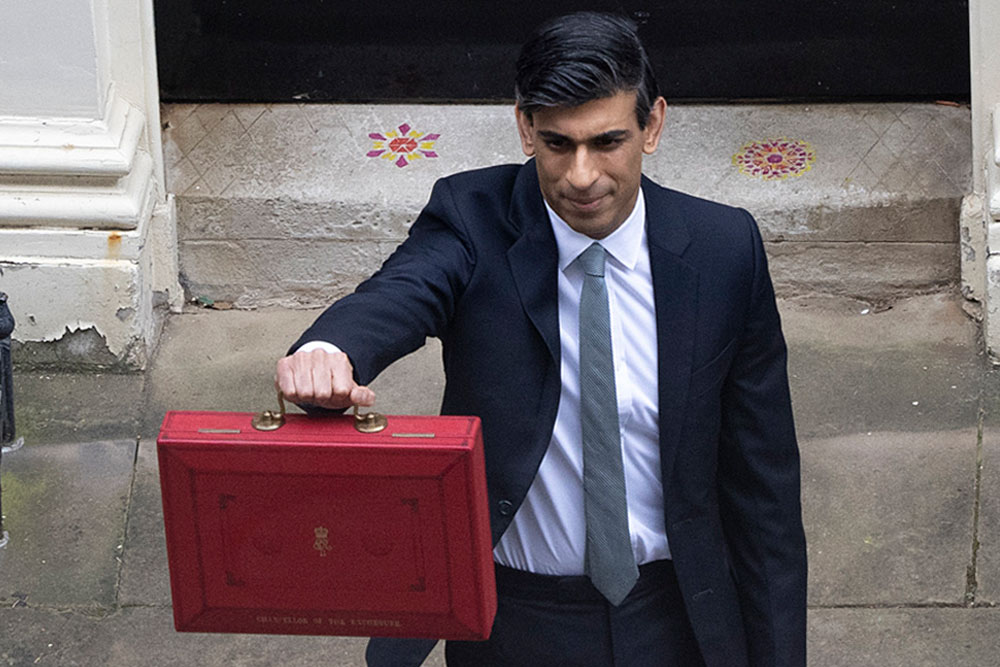Chancellor Rishi Sunak delivered a Budget last week that was widely trailed in slick videos released on social media. Unfortunately, it did not impress NHS think-tanks and unions, who were hoping for a recovery plan and action on social care. Lyn Whitfield reports.
It is exactly a year since chancellor Rishi Sunak stood up in the Commons to promise the NHS would get “whatever it costs” to cope with Covid-19. Last week, he delivered a Budget that was panned for failing to give the NHS anything like enough to cope with the aftermath of the pandemic.
Then, a day later, the government made a pay recommendation that triggered strike threats. So, with a new financial year just a few weeks away, what does the funding landscape look like? And what might it mean for health tech?
It’s a rise, it’s a cut…
In broad terms, the NHS funding figures are straightforward (the Health Service Journal published a useful summary). NHS England and Improvement has a long-term settlement with the Treasury to support its latest reform project, the NHS Long Term Plan.
As part of this settlement, it was due to receive £130 billion to fund NHS services in 2020-21. When the novel coronavirus arrived, “whatever it costs” turned out to be an additional £18 billion. NHSEI was due to receive £139 billion in 2021-22. The Budget confirmed it will get this, plus £3 billion announced in last autumn, of which £1 billion is earmarked for waiting lists and £500,000 for mental health services.
So, the NHS core budget is going to rise – and fall. It will rise in line with the Treasury settlement but fall in comparison to what it spent last year. Which is why the Labour Party and some unions have claimed that it is being ‘cut’ (The Guardian).
The ‘cut’ looks bigger if health-related, non-NHS Covid spending is included in the figures. The government laid out huge sums on personal protective equipment, NHS Test and Trace, the NHS Covid-19 app, and the vaccination programme last year.
Now, most of this spending will stop; although the Budget announced another £1.6 billion for the vaccination programme and another £15 billion for NHS Test and Trace. This will take NHST&T’s total funding to a truly staggering £37 billion (more than the country spends on police, courts, and prisons).
The Commons Public Accounts Committee has been asking searching questions about what the country is getting for this “unimaginable” amount of money. But putting NHST&T aside, it’s a stretch to call not spending on the pandemic an NHS cut.
Nothing for councils, nothing for social care
The real issue with next year’s NHS funding is that think-tanks, management and medical bodies think it won’t be anything like enough for the NHS to ‘reset’ and get on top of a waiting list that is now over 4.5 million people, of whom 300,000 have been waiting more than a year (Evening Standard).
Nuffield Trust chief executive Nigel Edwards said: “Recovery from the pandemic will take several years, not just for the economy, but for the NHS to work through waiting lists, boost capacity, and adjust to its ongoing demands.” He said it was striking that the Budget had failed to recognise or plan for this, and: “An increase in the NHS budget for the next financial year is likely to be needed.”
Saffron Cordery, the deputy chief executive of NHS Providers, which urged the government to leave NHS spending at £148 billion, since it is slated to get there under the Treasury settlement anyway, similarly argued that the Budget had “fallen short on setting out a strategic direction for public services” and predicted that the chancellor would have to come back to finish the job.
Meantime, the NHS does not operate in a vacuum. It might face less demand if public health was improved. Yet local authorities, which have hosted public health services since 2012, are facing further cuts to their budgets, as a result of the austerity “backed in” to the last public sector spending review, conducted before the pandemic.
Indeed, the BBC reported recently, a number of councils are on the verge of going bust. At the same time, the NHS needs social care services to keep elderly people and those living with long-term conditions out of hospital or to support them so they can be discharged promptly. Yet the Budget delivered nothing to social care and didn’t indicate when the much-delayed green paper might see the light of day.
Saffron Cordery said: “Successive governments have promised to fix social care and yet none have delivered the radical change we need. We are urging the government to deliver on its promise to unveil a plan for reforming social care by the end of the year.”
That pay offer…
The NHS also operates in the wider economy. The Office for Budget Responsibility reckons that GDP should bounce back to pre-pandemic levels by the middle of 2022, allowing government borrowing to fall sharply from its historically high levels, and the Budget’s tax rises to kick-in (the BBC’s Faisal Islam provided a useful analysis of what is meant to happen).
For the moment, though, the economy has taken a beating – and Brexit is not helping. The current situation is the government’s justification for its recommendation to the relevant NHS pay review bodies that staff should get a pay rise of just 1% next year. Or, given rising inflation, that they should take a pay cut.
Prime minister Boris Johnson said: “What we have done is try to give them as much as we can […] in pretty tough times” (BBC News). Ministers have also pointed out that there is a public sector pay freeze in place and many private sector workers could still lose their jobs.
However, the recommendation has infuriated unions, particularly those representing nurses and low-paid NHS staff. Some are threatening strike action (BBC News). There are concerns that it could impact recruitment and morale, just as the health service will need motivated staff to get stuck into the reset agenda.
No plan for investment, good luck with reform
In theory, the NHS Long Term Plan’s project to tackle demand and costs should take a significant step forward in April, when England will have integrated care systems in place. ICSs are tasked with creating ‘joined up’ care systems, shifting from contract management to population health management, and turning their attention to prevention and patient engagement.
However, they’ll need headroom to do this, and the Budget suggests there won’t be much headroom. Historically, the when faced with this kind of situation, the NHS has tended to screw down costs and focus on political imperatives. So there is a danger this will happen again.
The reform agenda will get pushed to one side, money will be channelled into the acute sector, and hospitals will run traditional waiting list initiatives. There are lots of reasons why this would be a bad thing, just one of which is that it would impact on IT.
There was a big uptake in technology during the first wave of Covid-19, which led to excited discussion about how there would be “no going back”. However, what most trusts deployed were remote working, virtual clinic and online consultation technologies.
Only a couple of organisations pushed ahead with electronic patient record deployments. So, there is still a big job of work to be done to complete the digitisation of hospitals. Last year, the National Audit Office called for a strategy to to get on top of this, aligned with incentives for trusts to invest in digital properly.
Neither have emerged. Meantime, the NHS is still waiting for a comprehensive spending review to deliver it a capital budget. And NHSX hasn’t managed to issue its promised documents on ‘what good looks like’ and ‘who pays for what’ (digitalhealth.net).
At the same time, it is now agreed that a ‘second wave of innovation’ is needed to support the ICS and transformation agendas. ICSs have been told to get a ‘basic’ or ‘minimum viable solution’ shared care record in place by September (Building Better Healthcare).
However, there is no money to do this. And, assuming ICSs can get traction, it’s not clear how the analytics, remote monitoring and digital patient solutions that they’ll need are going to plug and play.
Show us the money…
Two additional features of the health tech landscape that received considerable comment during the pandemic were the new spirit of collaboration that emerged between NHS organisations and their suppliers and a new willingness on the part of the staff to adopt digital solutions and new ways of working.
Will that survive the government’s decision to pit the public against the private sector in a row over pay? The health tech community will be hoping that it does, since staff and public demand could be a powerful driver for keeping up momentum.
The Budget could have helped by addressing think-tank and union demands for funded recovery plan or, even, a technology strategy for the wider economy. Since it didn’t, attention will turn to the summer spending review. The autumn could be pivotal.



